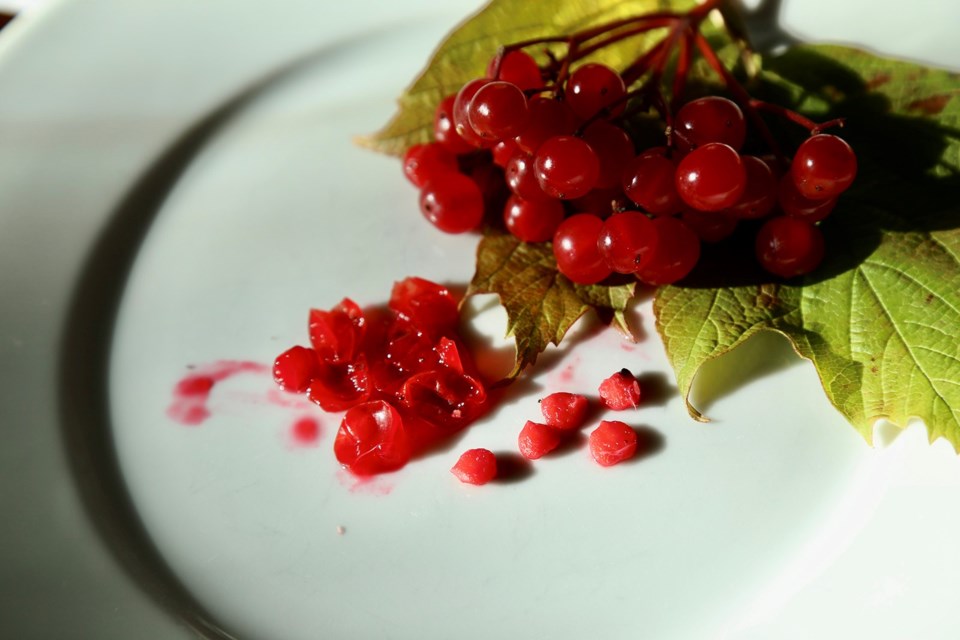I recently returned from a very low-tech week in the Cariboo with our youngest daughter, riding horses through quaking aspen, lodgepole pine and black cottonwood forest, and using a wood stove for heat and to cook modest meals.
Slowing down in remote nature inspired reflection, and encouraged us to think deeply about Canada. We reflected on its past and its future, and what we can do to preserve and restore the country’s natural heritage, and reconcile our transgressions.
Driving home along highways 24, 97 and 99, through the Fraser Canyon and across through Lillooet, reminded me how much our planet has changed in a relatively short span of time, and the importance of repairing our disconnect from nature.
As if on queue upon arriving home, and just in time for Thanksgiving, the highbush cranberries in our tiny boulevard pine forest habitat were at peak ripeness. I will harvest some for maple and shallot-sweetened cranberry sauce, but leave the majority for the birds, squirrels and insects that frequent the ecosystem.
Viburnum opulus var. americanum (trilobum), commonly known as highbush cranberry (not a true cranberry), is native to all Canadian provinces, and is a survival food for small and game birds, deer, moose, bear and small mammals including beaver.
After learning some time ago that pemmican, a winter survival food for Indigenous peoples, was made from dried and pounded bison meat, bison tallow and dried highbush cranberries, I purchased my first small plant. That plant and several others have since grown into large shrubs, providing food, shelter and shade for wildlife.
Vibernums are of the honeysuckle family, and like many honeysuckles, highbush cranberries ripen to a brilliant translucent red. The fruits are drupes, like olives, and contain substantial disc-like seeds that germinate in the wild after two cycles of cold winters followed by warmth.
In late spring, when the sky is still drizzly and grey, our garden lights up with halos of flat white decorative bait “flowers” surrounding a cluster of tiny butter-yellow and white flowers with Martian-like stamen. Once the interior flowers have been pollinated, beginning their mystical transition to drupes, the spent bait petals fall away like wedding confetti.
Much like their woodsmates, snowberries, mature highbush cranberries remain clinging in clusters to their branches, long after their frost-bitten leaves have fallen to the ground.
To Canadian culinary anthropology nerds like myself, highbush cranberry plants are a national treasure. Their leaves look much like maple leaves (minus two lobes), and they turn every shade of blazing orange, red and purple in the fall. Moose, geese and beaver eat them mind, so it seems to me that we should love these plants and grow them in abundance, and yes perhaps even emboss their likeness onto loonies.
Fair warning that upon crushing fully ripe highbush cranberries, one notices a slightly off-putting cheesy aroma somewhat reminiscent of wet woollen socks, but this passes quickly. I imagine that nature designed this feature to lead animals to food in the wake of the berries being crushed in the wind and underfoot.
Highbush cranberries are high in vitamins C and A, and extraordinarily high in antioxidant phytonutrients like anthocyanin, which gives the berries their beautiful, hand-staining colour.
The maintenance-free bushes, which top out at about moose-head height, prefer direct sun and modest moisture, but they also grow in part-sun in our backyard rain garden.
Small highbush cranberry bushes can be purchased from native plant nurseries across the country. A searchable-by-province native plant suppliers list is posted on the Canadian Wildlife Federation website.
Laura Marie Neubert is a West Vancouver-based urban permaculture designer. Follow her on Instagram @upfrontandbeautiful, learn more about permaculture by visiting her Upfront & Beautiful website or email your questions to her here.
For a taste of permaculture, watch the video below:




